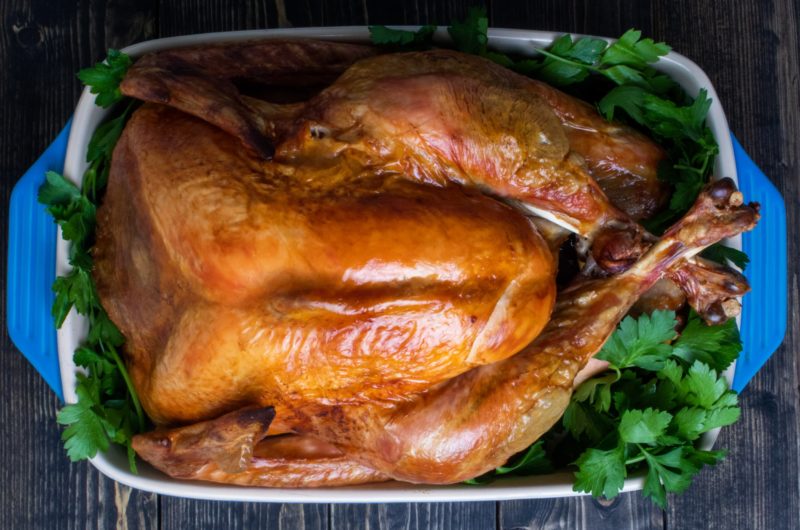Ever since I started hosting Thanksgiving, I’ve been chasing the Norman Rockwell vision of a perfectly brown turkey.
And I have ruined these birds every. Single. Year.
I’ve watched the light of anticipation turn into polite smiles around labored mastication and requests for more gravy that I’m always out of.
Because to get that brown, gorgeous crust, you almost have to overcook the damn thing.
Except you don’t.
Everyone is always on about injecting, or brining, or stuffing butter under the skin or doing other things that make it possible to cook the thing long enough to brown it without drying it out.
The real secret is getting it to brown faster so you don’t HAVE to cook it longer.
And I think I have finally cracked that code. The secret is air drying it before roasting it. Though I also always brine my birds so they taste better.
So, here’s the recipe for a nice, simple, brined turkey. It’s not so much a recipe as it is a method, which makes it useful for turkeys or turkey breasts of all sizes. So if you’re cooking for fewer this Thanksgiving, it’ll work out great for you.
Here goes:
Thanksgiving Brined Turkey Recipe
Course: MainCuisine: AmericanDifficulty: Easy4-8
servings3
hours3
hoursI’ve spent years overthinking turkey, and always ended up with beautiful, but dry bird. This year, I cooked many turkeys trying to land on the perfect recipe and method, and I think I’ve found it. And it’s literally the only time I’ve experienced simple actually being better.
Ingredients
A fresh or frozen turkey or turkey breast that has not had anything added to it.* The cooking time varies based on weight.
Water – enough to cover the turkey
Salt – 3 % of the water by volume
Room temperature salted butter – enough to coat the entire raw bird
Directions
- Defrosting
- Three days before roasting, begin to defrost your turkey, in the package, in the fridge.
- Brining
- Remove your thawed or mostly thawed turkey from it’s packaging and remove the neck and giblets, or gravy packet, or whatever else the manufacturer has stuffed int he cavity.
- Put the turkey into a vessel that can hold it with a few inches of clearance at the top.
- Using the biggest measuring cup you have, pour water into the vessel until it covers the turkey by at least 2 inches. Make sure to keep track of how much water you have added.
- Remove the turkey and set it aside. Add 3% salt by volume. For instance, if you needed 3,785 ml (1 gallon) of water to cover the bird, add 114 g (~4 oz) salt. Stir until fully dissolved and the water becomes clear again.
- Put the turkey back in the brine and cover with plastic wrap. Store in the fridge or somewhere else where the turkey and brine will be kept below 40 degrees F, the cooler the better.
- Drying and Prepping
- Preheat oven to 450F
- The day of roasting, remove the turkey from the brine and place it on a roasting rack in the roasting pan. Air dry for at least 3 hours.* Bigger birds will obviously take longer to dry. The skin should darken and feel parchment-like to the touch. It looks blotchy and awful, but trust me, it’s fine 😀
- Once dry, Cross legs and truss together
- Rub room temperature salted butter all over the bird, making sure to cover breast, legs and wings evenly
- Roasting
- Place uncovered turkey in a 450F oven. After 30 minutes, turn heat down to 350 and cook until the instant read thermometer pops up or the thickest part of the bird reaches an internal temperature of 155F. **
- Remove from oven and rest, covered in foil, for at least half an hour. Carve and serve.
Notes
- *Against all FDA and producer guidance, I let my turkey air dry on my counter top under an air vent, and come up to room temp just before I pop it in the oven. This reduces cook time by almost half. If I have kept it cold enough in the brine, the chances of it making anyone sick are negligible in my opinion. You can air dry it in the fridge, but it will take longer. Might recommend drying it overnight.
- **FDA recommends an internal temp of 165F. I find that this can be achieved during the resting period as the bird continues to cook. If I bring it to 165F in the oven it tends to dry out.



Leave a comment